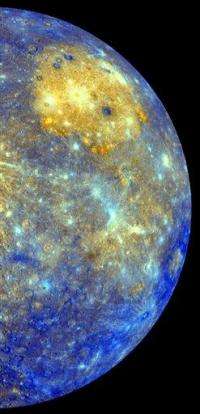NASA spacecraft trying to get into Mercury's orbit

A desk-sized NASA spacecraft is riding the brakes all the way to Mercury, about to pull a tricky maneuver Thursday night to become the first man-made object to orbit the tiny planet.
After a trip of 4.9 billion miles and nearly six-and-a-half years, the Messenger spacecraft will try to careen into an egg-shaped orbit and fight off the gigantic gravitational pull of the sun. To do so, it will have to use more than half of the fuel it was launched with in 2004 to reduce speed dramatically in just fifteen minutes.
If all works well, Messenger will circle as close as 120 miles from the surface and survey the entire planet for a year, beginning April 4. It will learn about Mercury's mysterious magnetic field and - most tantalizing of all - discover if the closest-planet-to-the-sun has ice in its permanently dark frigid craters near its poles.
If all doesn't go well, it is more likely that the $446 million spacecraft flies away from Mercury and ends up circling the sun. NASA should know whether they succeed in about an hour.
Making it difficult has been the sun's gravity and its incredible heat, forcing the probe to have large sunshades, said mission systems engineer Eric Finnegan. Messenger has had to take the long way around to get into Mercury's orbit because it has to continuously slow down and burn energy to get to the right place. While other spaceships have whipped around planets like a slingshot to speed up, Messenger has had to do just the opposite, going around Earth, Venus and Mercury to slow down.
"You're playing this incredible game of cosmic billiard balls to make this all work out," said Johns Hopkins University astronomer Ralph McNutt, who is a mission scientist.
If something goes wrong, engineers have fallback plans they can use in the next three days to three months to try to get the spacecraft back in some kind of orbit around Mercury.
NASA is shuttering the cameras on the spacecraft during the maneuver so there will be no pictures of the arrival, said mission chief scientist Sean Solomon.
Messenger has flown by Mercury a few times in its torturous trip there and Mariner 10 flew by there 36 years ago.
"Mercury has been called the forgotten planet because it's been so long since we sent a spacecraft there," Solomon said.
But that is about to change.
More information: Messenger spacecraft: http://bit.ly/eqUYR8
©2010 The Associated Press. All rights reserved. This material may not be published, broadcast, rewritten or redistributed.



















